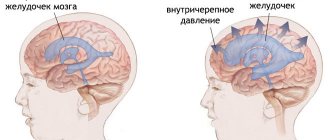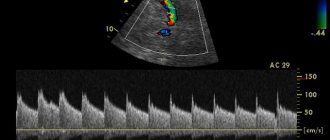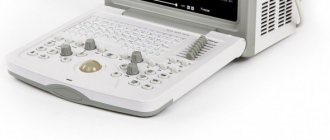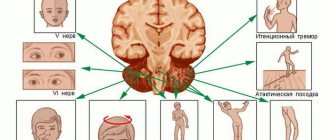The birth of a desired child is always a great joy for young parents and those around them. But along with the little diva, a lot of new troubles arise in the family related to caring for the baby and his health. Often, new moms and dads have to hear various kinds of diagnoses, among which increased intracranial pressure is far from the least important. What is intracranial hypertension in infants? How dangerous is this disease, and what modern treatment methods will help get rid of this disease?
Intracranial hypertension in infants is manifested by increased pressure inside the skull as a result of excessive production of cerebrospinal fluid or cerebrospinal fluid. But this condition is not always regarded as a pathology.
The appearance of symptoms of increased intracranial pressure in infants is diagnosed during the act of defecation, breastfeeding, sneezing and even laughter. This condition is not life-threatening for the child; it is temporary and can therefore remain unattended.
Another thing is constant intracranial or intracranial hypertension in a child, which is accompanied by the appearance of a number of pathological symptoms and prevents the baby’s central nervous system from developing normally. Parents must immediately respond to such a pathological process and eliminate it using modern methods of drug correction.
Causes of increased pressure
Intracranial hypertension in children in the first months of life is not an independent disease. It occurs against the background of other pathological conditions, including:
- benign tumors and malignant formations in the child’s brain;
- inflammation of the meninges;
- infection of the soft tissues of the central nervous system;
- swelling of the brain associated with the influence of toxic factors on the baby’s body;
- hydrocephalus or increased accumulation of cerebrospinal fluid in the skull;
- abnormalities in the development of central nervous system structures;
- traumatic brain injuries, including birth mechanical injuries;
- intrauterine infection of the fetus;
- intrauterine growth retardation, hypoxia;
- cerebral hematomas;
- untimely fusion of the skull bones.
In most clinical cases, the cause of increased intracranial pressure in children under one year of age is hydrocephalus, caused by developmental disorders of the child in the womb.
This pathological condition develops as a result of infection of the unborn baby by microbial and viral agents of a pregnant woman, a delay in its development, or the presence of congenital malformations of the brain of the central nervous system.
Manifestation of intracranial pressure in children
Increased intracranial pressure in a baby is often accompanied by severe and frequent anxiety, changes in mood, and hyperactivity. If the baby cries for no reason, often worries and twitches, then you should think: maybe this is just a symptom of ICP and causes a headache in the baby. Often the baby refuses to breastfeed and may also spit up profusely.
In some cases, the pressure rises periodically and temporarily, and then returns to normal in a short time, so the malaise is often difficult to notice. In such cases, you should monitor the main symptom, which can be called crying for no apparent reason and anxiety. It is important to remember that a newborn up to 2 months should sleep most of the time. Newborns cry when there is discomfort, for example, due to a wet diaper or hunger. If the baby cries , bends over and often wakes up more than 5 times a night, this is a serious reason to take the child to the pediatrician.
Correct and timely diagnosis of intracranial pressure in children can begin with a routine visual examination, in which you should pay attention to indicators such as head volume, as well as the size of the fontanel. It should be remembered that in a one-year-old child the fontanel should be completely overgrown. Another important point during the examination is checking muscle tone and the baby’s reaction to external stimuli. These simple methods help in 95% of cases to notice the first signs of abnormalities.
Features of clinical symptoms
Signs of intracranial hypertension in newborns largely depend on the nature of the underlying disease, which caused the development of symptoms of high pressure in the central nervous system. In infants, ICP manifests itself:
- restlessness, increased irritability and severe crying, especially at night or when in a horizontal position;
- disturbances in normal sleep function, frequent waking up, difficulty falling asleep, etc.;
- regular regurgitation with copious discharge of stomach contents;
- nausea and periodic vomiting;
- an increase in the size of the skull with the appearance of a developed venous network on the scalp;
- swelling of the large fontanel and its non-compliance with age-old norms;
- dysfunction of the visual analyzer, when disturbances occur in the functioning of the optic nerves, a strip of sclera appears between the upper eyelid and the upper edge of the iris, as well as downward deviation of the eyes;
- lack of appetite and lethargy during feeding (the child does not take and suckle well, refuses the bottle, cries);
- slight weight gain or its complete absence;
- delay in psycho-emotional development.
Intracranial hypertension syndrome in children is dangerous due to its complications , which not only significantly reduce the quality of life of a newborn, but can also cause his death. Among these consequences of the disease are:
- severe mental disorders;
- severe forms of visual impairment;
- epilepsy;
- movement disorder syndrome;
- strokes with the formation of foci of ischemia in the head section of the central nervous system;
- hemorrhages in the soft tissues of the brain;
- apnea.
What symptoms may indicate increased intracranial pressure in infants?
- excessive tearfulness, irritability;
- lethargy and drowsiness;
- restless sleep;
- nausea, frequent regurgitation;
- Greffe's symptom - the white sclera is clearly visible between the iris and the upper eyelid, and the eyes look down;
- throwing the head back;
- flinching;
- protrusion of the eyes;
- lack of weight gain.
A small child cannot yet tell about his well-being; from his behavior one can only guess about any problems in his health.
At the first manifestations of the disease, immediate consultation with a doctor is necessary.
Diagnostics
An examination by a neurologist will help confirm the parents' suspicions about the appearance of signs of increased intracranial pressure in the infant. Using a special technique, the doctor determines deviations in reflexes, evaluates the visual enlargement of the skull and large fontanel. In addition, upon examination, you can confirm the presence of changes in the eyeballs, a slight increase in weight and deviations in the psycho-emotional sphere of the baby.
In infants, the most informative method for diagnosing the disease is a neurosonographic examination, which is an ultrasound version of determining the state of brain structures by moving a sensor in the area of a loose fontanel. Using this technique, it becomes possible to detect enlarged ventricular cavities, interhemispheric fissure, etc.
Currently, neurosonography is considered the safest method for determining the symptoms of intracranial hypertension in children.
This measurement of intracranial pressure is used only in relation to infants who have a patent fontanel, while in older children it is necessary to carry out a computed tomography scan of the cranial part of the head.
The only diagnostic option that allows you to determine quantitative indicators of intracranial hypertension in an infant is puncture of the spinal canal. This technique is implemented extremely rarely in practice and only when there are absolute indications, which is associated with a high risk of developing post-invasive complications in infants.
What are the symptoms to determine ICP?
The causes of intracranial pressure in children can be different, just like their symptoms.
. Based on the fact that ICP can cause discomfort to both newborns and older children, the characteristic signs of its manifestation can be divided into two groups.
So, the symptoms of intracranial pressure in infants can be considered:
- Changing the size of the fontanel. It becomes larger, begins to pulsate and periodically swell.
- Convulsions appear.
- The baby's head increases in size.
- The cranial sutures may separate.
- The baby begins to bulge his eyes.
- At night, when the baby is sleeping, which means his body is in a horizontal position, parents may encounter anxiety, whims, and crying. This is due to the fact that in this position the venous outflow slows down, and the baby experiences discomfort.
- Veins filled with blood become noticeable in the head area.
- Throughout the day, the child has frequent regurgitation.
- The baby becomes lethargic, moves little, and is not interested in what is happening around him.
- There is a decrease in weight due to the fact that the baby refuses to latch on to the breast.
- There may be disturbances in the development of children.
In older children, namely from 3 to 7 years, the presence of ICP can be determined by the following signs:
- The baby is developmentally delayed.
- Memory, handwriting, and attention deteriorate.
- In children, the forehead may increase in size, at the same time the eyes become slightly closed.
- Problems arise associated with blurred vision and pain in the eye area.
- There is a deterioration in mood and general condition. The child constantly wants to sleep, is capricious and cries.
- Children get tired quickly and feel weak.
- There are regular complaints of headaches and attacks of nausea, which often end in vomiting.
- Coordination deteriorates, children speak poorly.
Modern approaches to treatment
Fortunately, hypertension in newborns is currently quite treatable. The choice of treatment tactics for intracranial pressure in infants depends on the pathogenesis of the underlying disease. In general, experts recommend that parents of a sick child spend more time in the fresh air, develop their own method of moderate physical activity for the child, and normalize his sleep and wakefulness.
High blood pressure therapy includes the prescription of the following groups of medications:
- diuretics, which allow you to get rid of excess fluid in the body ( Diacarb, Asparkam );
- nootropic drugs that have a positive effect on blood supply and trophism of the brain;
- neuroprotectors that protect the soft tissues of the central nervous system from harmful influences;
- medications that have a sedative effect.
During the period of remission, young patients are shown physiotherapeutic procedures that improve cerebral circulation, eliminate residual foci of congestion, and prevent relapses of the disease.
Surgical treatment is indicated for infants in whom high intracranial pressure is caused by tumor processes. In such cases, the child undergoes radical surgery to remove the formation.
For tumors and anatomical abnormalities, surgical treatment is used.
One of the most common types of surgery for hydrocephalus is ventriculoperitoneal shunting.
What is it and why does it occur?
Intracranial pressure in children is not an independent diagnosis. This change in the body indicates that certain malfunctions have occurred in it, which need to be determined in order to stabilize the condition of the baby.
ICP increases due to the fact that the amount of cerebrospinal fluid in the spinal canal and ventricles of the brain increases.
The causes of intracranial pressure in children may be the following:
- A difficult pregnancy, during which the expectant mother suffered severe toxicosis and was diagnosed with placental abruption.
- Lack of oxygen, which was a consequence of problems that arose during labor, entanglement of the fetus with the umbilical cord.
As a result, the newborn’s brain is in a stressful state and tries to eliminate its deficiency. As a result, increased production of fluid, the excess of which contributes to pressure on the brain.
- Congenital or acquired hydrocephalus, which is a fairly serious cause, the timely identification of which will allow for proper treatment.
Hydrocephalus consists of increased fluid production due to hemorrhage or as a result of heredity.
- Inflammatory processes of the brain, as well as tumors, hematomas or injuries. In this case, the amount of fluid produced cannot be regulated on its own, which requires surgical intervention.
- The baby was diagnosed with premature aging of the cranial bones.
Recommendations for parents
Most parents consider increased intracranial pressure to be an incurable condition, but this is only a common misconception. Currently, there are a large number of medications and modern surgical treatment methods that can be used to cope with the disease.
The main rule for parents is to strictly follow the instructions of the attending physician.
Treatment of increased intracranial pressure should be comprehensive and individually selected by a doctor and carried out under his supervision. In most cases, intracranial hypertension is caused by pathologies during pregnancy and complicated childbirth and is not a hereditary disease.








